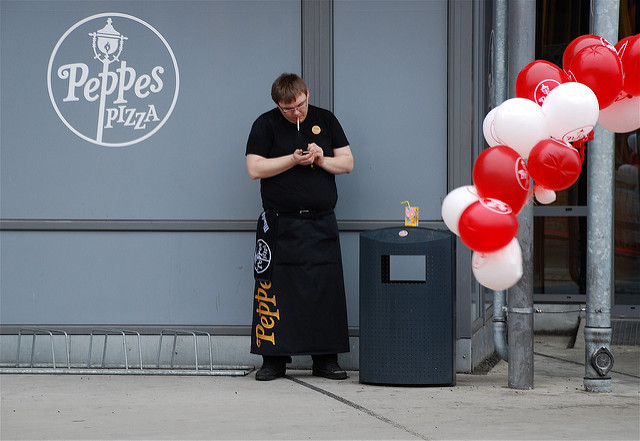Search Results: one of the few
The Best Kind Of Self-Promotion
 A new group fitness instructor arrives to teach a class at the gym. He’s an unknown quantity, but a few people give him a shot. Within a month his class is either packed or half-empty. The instructor who is struggling to get the numbers announces details of his upcoming classes at the end of each session. The one with a full house doesn’t need to utter a word.
A new group fitness instructor arrives to teach a class at the gym. He’s an unknown quantity, but a few people give him a shot. Within a month his class is either packed or half-empty. The instructor who is struggling to get the numbers announces details of his upcoming classes at the end of each session. The one with a full house doesn’t need to utter a word.
The difference isn’t that the most popular instructors are more professional or technically proficient—it’s that the people who take part in their classes leave feeling glad that they came.
The feeling we leave our clients and customers with (about themselves and not us) as they walk out the door is the best self-promotion money can’t buy. No amount of pleading and persuading beats the delivery of an exceptional experience that the customer wants to repeat.
Image by Edson Hong.
Three Steps To Telling Better Product Stories
filed in Marketing, Storytelling
 When it comes to marketing our products and services there are a couple of storylines we fall back on. We either invite prospective customers to look at our impressive features and benefits or urge them to notice how much better our product is than anything else that exists in the category. Those tactics may have worked in the old two-channel world when customers were less distracted and had fewer choices, but they don’t cut through now.
When it comes to marketing our products and services there are a couple of storylines we fall back on. We either invite prospective customers to look at our impressive features and benefits or urge them to notice how much better our product is than anything else that exists in the category. Those tactics may have worked in the old two-channel world when customers were less distracted and had fewer choices, but they don’t cut through now.
The much more effective alternative is to anchor your customer in his world, starting with his story.
How To Begin Telling Better Product Stories
1. Speak to one person.
2. Anchor him in his current imperfect reality.
3. Show him what his new desired reality could be in the presence of your product.
See how Google does this brilliantly with a great piece of product storytelling.
Not only does this alternative strategy make us better marketers, it also helps us to be more empathetic to our customers—which makes for better products and experiences for the people we serve.
If you want to become a better marketer and brand storyteller, join us next week on the upcoming
Story Strategy Course.
Image by Hsuanya Tsai.
A Common Sense Approach To Customer Insights
filed in Innovation, Marketing, Strategy
 Joanne is a small business owner. She operates a catering van that travels to local industrial estates, serving workers who don’t have easy access to high street cafes and fast food restaurants closer to town. Joanne’s business lives and dies on what she knows about her customers. So she makes it her business to know a lot about them.
Joanne is a small business owner. She operates a catering van that travels to local industrial estates, serving workers who don’t have easy access to high street cafes and fast food restaurants closer to town. Joanne’s business lives and dies on what she knows about her customers. So she makes it her business to know a lot about them.
She knows that Darren leaves home without breakfast before his kids are up. There is no time to pack lunch because he has to be on the road before rush hour traffic hits. Joanne knows that most days Darren stops at the convenience store for a Red Bull which he drinks in his truck before beginning a day of sawing, sanding and heavy lifting. Unlike the office workers in the city who work from 9-5 and lunch at midday, Darren will be famished by 10–which is why her van makes its rounds before 11. She knows he needs something he can eat with one hand while standing in his workshop between jobs, and that he won’t be looking for sushi or a paleo salad bowl. Joanne knows that Darren will knock off early on Friday and head to the pub for a few beers with his mates. He will do the garden on Saturday and take his boys to footie on Sunday.
These insights are invaluable to Joanne’s business. They influence her hours of operation, the products she stocks and the customer experience she provides. And she didn’t need a data analyst or an algorithm to uncover them.
We can learn as much from spending time with our customers as we can by looking for clues among surveys, demographics and data sets. It turns out that understanding comes from looking beyond data points that can be easily measured or plotted on a graph. How much do you know about how your customers behave or what they think about, prioritise, value and believe in?
Image by Michelle Ress.
The Purpose Of Design Features
 In business, we use design to differentiate ourselves in a number of ways. Design features are primarily seen as a way to attract customers and to help them decide if our product is for them. In a digital world, design is one of the best tools we have to build trust with customers we many never meet face-to-face.
In business, we use design to differentiate ourselves in a number of ways. Design features are primarily seen as a way to attract customers and to help them decide if our product is for them. In a digital world, design is one of the best tools we have to build trust with customers we many never meet face-to-face.
But in our rush to simply stand out, we often overlook the opportunity design affords us to create deeper connections with prospective customers. Thoughtful design can show people what we stand for and what we value. When we get it right it makes them glad they chose our brand and gives them a reason to share it.
When more purchasing decisions are made online, it gets harder to justify design decisions that cost more. After all the customer is not holding the box, bag or book in their hand before they click ‘buy’. If we’ve already sold them, there’s no need to sustain the effort or increase the expense. And yet when we do it changes everything.
The quality of the packing, the weight of the paper, the colour of ink and type of materials we use—every one of these choices communicates our intention to the customer and gives him a story to tell. Design isn’t just about outward appearances and conversions in the moment. It’s a way to engage more deeply with customers in a world where there are fewer and fewer opportunities to do so and how we create great experiences that are talked about long after the purchase is made. Thoughtful design allows customers to become advocates who are delighted to pass our story or idea along and it’s often the smartest and most effective marketing investment we can make.
Image by Merlijn Hoek.
Surviving Peak Utility
filed in Strategy
 When I was a child our family doctor operated a first come, first served, clinic without an appointment system. Some patients arrived three hours before the clinic was due to start to make sure they’d be seen first and a two-hour wait to see the doctor was not uncommon.
When I was a child our family doctor operated a first come, first served, clinic without an appointment system. Some patients arrived three hours before the clinic was due to start to make sure they’d be seen first and a two-hour wait to see the doctor was not uncommon.
“Evening folks.” Dr. Mac said, as he walked through the waiting room to his office, where he would smoke a quick cigarette before seeing the first patient. True story! In those days the family doctor was akin to a god and people accepted the wait and inconvenience without complaint.
Dr. Mac lived and worked in a world with fewer doctors and no prescribing pharmacists, nurse practitioners or alternative medicine, so his services (no matter how average) were highly valued.
Today, in the Western world where patients have endless treatment choices and are better informed about their health, things look very different for family doctors. Patients are no longer happy to wait an hour for a brief consultation with the doctor when they can get more convenient access and treatment, or a much better experience elsewhere. What was once viewed as an invaluable professional service is now almost seen as a standard utility. The reality is that people don’t just want to the doctor to make them better. They want to feel better. And they are choosing alternatives (sometimes more expensive ones) that deliver that feeling.
The same story is playing out across every industry from transport to travel, health to hospitality. Monopolies are being eroded as alternative services that provide better experiences and give people what they want, when and how they want it are thriving.
Dr. Mac would not survive today, not because minor illnesses or their treatment have changed all that much in forty years, but because people’s expectations about what’s worth seeking out, waiting and paying for have changed beyond all recognition. We have reached ‘peak utility’—we are living at a time when average products and standard services are becoming less valuable by the day. Our customer’s and user’s expectations have shifted and if we want our businesses to survive and thrive we have no alternative but to move with them.
Image by Jason Parks.
The Difference Between Saying You Care And Caring
filed in Marketing, Storytelling
 I’m not sure when we became defensive about customer care became. I suspect it might have been when we began to put more distance between the customer and us. In the days when there was a cash register that rang with ‘real money’, when we sold eye-to-eye and transacted hand-to-hand, instead of digitally, we had no choice but to ‘see’ our customers. The transaction itself was as good as a handshake. Word and bond. No us and them, only us.
I’m not sure when we became defensive about customer care became. I suspect it might have been when we began to put more distance between the customer and us. In the days when there was a cash register that rang with ‘real money’, when we sold eye-to-eye and transacted hand-to-hand, instead of digitally, we had no choice but to ‘see’ our customers. The transaction itself was as good as a handshake. Word and bond. No us and them, only us.
Now we build barriers. We expect the customer, not the company, to take responsibility. We create guarantees that protect us from having to fulfil them. We armour up against customers. We require proof of purchase that leaves no room for us to be exploited by the shady few and sadly, fewer opportunities to delight the honest majority.
So when we find a company that cares, no questions asked we should celebrate them. When I buy a Crumpler bag it comes with a lifetime warranty. If it fails, I can bring it back, and they will repair it. The only proof of purchase I need is the product that let me down. What a breath of fresh air.
Caring is simpler than you think. What story does your customer care tell about your company?
Image by Anna D.
How To Reach Your Customers
 Here’s how our customer’s time was spent across the various media platforms in 2015.
Here’s how our customer’s time was spent across the various media platforms in 2015.
Print 4%
Radio 13%
TV 36%
Internet 22%
Mobile 25%
Here’s where we spent our dollars trying to reach them.
Print 16%
Radio 10%
TV 39%
Internet 23%
Mobile 12%

While we’re spending money in places where fewer of our customers are engaging (print and TV), we’re missing opportunities to meet them where they are (mobile). According to Meeker’s Annual Internet Trends Report, this represents a $22 billion opportunity in the US alone.
The best way to reach your customers is to meet them where they are.
It might not be where you assumed they’d be.
Image by Pieter van Marion.
What’s Your Big Idea?
filed in Storytelling, Strategy
 Every great brand leads with one big idea. The big idea is what the brand stands for—it’s core belief. Articulating the big idea is harder than you think, living it every day is even harder than that.
Every great brand leads with one big idea. The big idea is what the brand stands for—it’s core belief. Articulating the big idea is harder than you think, living it every day is even harder than that.
The brands that do have a much easier time differentiating themselves from the competition. Here are a few examples.
Starbucks—The local cafe should be a ‘third place’ between home and work.
Marie Kondo—Tidying up has the power to transform your life.
Warby Parker—Prescription eyewear should be stylish and affordable (under $100).
Go-To—Skin care should be free of confusion, cruelty and faux-science.
Lune—A great croissant is created with attention to detail at every stage in the making process.
Patagonia—Business must inspire and implement solutions to the environmental crisis and do no harm.
School of Life—Emotional Intelligence is a life skill that everyone needs help to develop.
Banksy—Art belongs to the people.
What’s your big idea?
Image by carnagenyc
The Value Of Challenging Our Assumptions
 It’s 6am, and a passer-by bends down to leave a couple of bananas next to the homeless guy who is turning over in his sleeping bag in the doorway of 7-Eleven. When he wakes, he gathers his things and the few coins in his tin. He drops the fruit in a nearby bin and heads into the city.
It’s 6am, and a passer-by bends down to leave a couple of bananas next to the homeless guy who is turning over in his sleeping bag in the doorway of 7-Eleven. When he wakes, he gathers his things and the few coins in his tin. He drops the fruit in a nearby bin and heads into the city.
The passer-by made an assumption about how best to help. But despite her good intentions their worldviews didn’t align.
This misalignment between giver and receiver, provider and user, business and customer occurs all too often. It happens when our understanding of the people we serve falls short—when we’re more focused on our story than we are on theirs.
We can challenge our assumptions about our customer’s wants and needs with knowledge, proof and truth. We seek those out by noticing, questioning, and understanding.
How are you doing that in your business?
Image by Gary Knight.
 The sign had been hastily scrawled in blue biro. The letters gone over and over again to make them more visible to the passer-by. A short cut, that in the end didn’t give the benefit of a short cut at all.
The sign had been hastily scrawled in blue biro. The letters gone over and over again to make them more visible to the passer-by. A short cut, that in the end didn’t give the benefit of a short cut at all.